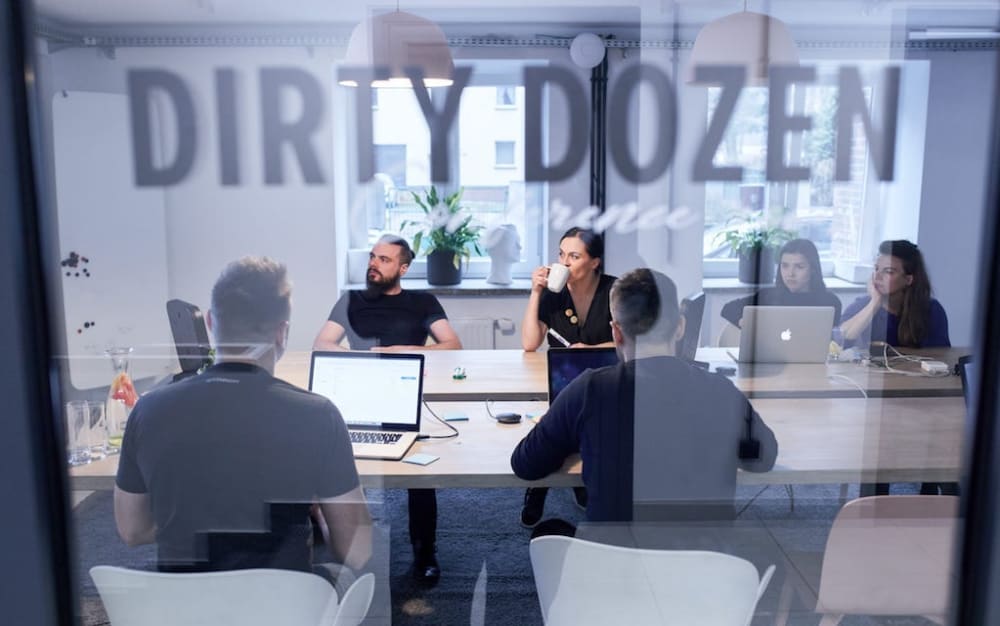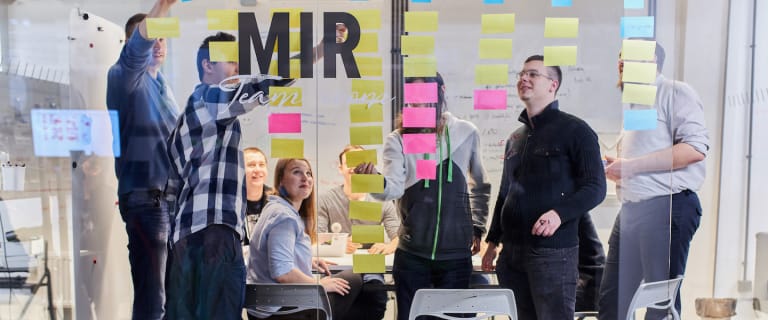Minimum Viable Products? It’s all about the team
Creating a minimum viable product (MVP) is a critical stage in the way we develop products at Boldare. Key to success is the MVP team. By ensuring each team has a unique balance of skills and experience, we can provide an extremely rapid and agile development service.

Table of contents
At Boldare, we take pride in our teamwork. Not just because we all get along just fine but because we take great care in assembling the right team for the client… in putting a group of people together with all the necessary skills and knowledge to ideate, design and develop your web experience.
From initial product workshop to market-tested scalable product, our teams are high-performing from the get go and capable of shifting their focus and process depending on what stage the project is at.
When working on an MVP (minimum viable product), a Boldare team brings a very specific skill set and approach to bear.
>> Learn more about our process: Full Cycle Product Development
Quick context: What’s a Minimum Viable Product?
The MVP is a core element (perhaps the core element) of our lean startup approach to product development. The minimum viable product is not a prototype. Nor is it a full-scale product ready for market. The MVP is an experiment, a way to test real-life user responses to an aspect of the solution being developed. It’s a way of testing and refining project assumptions in order to create a product that genuinely meets user needs.
As a method of gathering rapid feedback on specific design features, it’s hard to beat a minimum viable product and some projects may involve a series of MVP experiments as stepping stones toward a final result.

Responses to a minimum viable product enable the team to gain a deeper understanding of:
- The central problem and whether the product so far is on track to solve it.
- The target audience for the product – Is the product pitched at the right people and, if so, is it giving them what they really need?
- Necessary future development – Each MVP is a signpost pointing to the next stage of the design project (and not always in the direction anticipated at project kick-off).
Putting together a Minimum Viable Product team
The accountabilities of an MVP team can be summarized as:
- testing the product hypothesis with minimal resources;
- putting together a most basic solution to solve the problem (or part of the problem);
- designing and developing a viable (partial) version of the product; and
- gathering and analyzing feedback from the test audience.
In light of these accountabilities, then depending on the nature of the project and the product being developed, the MVP team typically includes people skilled in a variety of key roles:
- Frontend Developer
- Backend Developer
- Visual Designer
- Interaction Designer
- UX Designer
- Product Designer
- Business Analyst
- DevOps
- Qualitative/Quantitative Design Researcher
- Digital Strategist
- Scrum Master
The purpose of the team is to create the MVP quickly (usually, design sprints take place over a two-week period) and get it to users for feedback. The construction of the MVP will incorporate any lessons learned from previous feedback and discussion and may include a prototype stage, depending on the needs of the product. The responses to any project prototypes will influence the choice of features to be tested by the MVP.

When deciding on who specifically should be a member of the team, we apply our team selection criteria:
- People who have worked together in the past – The performance of any team depends at least in part on familiarity between the team members. With this in mind, we always include at least two team members who worked together on a previous project. This helps the new team accelerate through (or even skip) the forming and storming stages of the team development process, arriving at the point at which they can deliver real value to the client much more quickly than a team that starts out as strangers.
- Skilled, self-organizing people – We select a balance of complementary soft and hard skills so that we have everything in the team we need to deliver what is needed to reach your business goals.
- People with mixed levels of seniority – Experience is invaluable. But so is a fresh perspective. With our MVP teams, we strive for a combination that can leverage both for the client.
Having so far delivered more than 250 digital products over a 14-year period, we understand that effective minimum viable products (and eventually, high quality full products) are built by teams that can innovate, think fresh and at the same time bring their deep experience to bear on the development process.
The perfect Minimum Viable Product culture
Every organization, and every team, has a culture – a set of norms and values that influence attitudes, behaviors and how the people in that organization or team work together.
Here at Boldare, an MVP team works on the following principles:
- Pro-risk – The whole point of the lean startup approach is to deal with projects in which the shape of the resulting product is not known at the outset. Hence the step-by-step process of experimentation using MVPs. When we don’t know exactly what success looks like, risks must be taken.
- Agility – We are an agile organization and all our teams are at home in constantly changing environments, working with disruptive technologies via rapid iterations and experimentation and if the feedback tells us the current direction is wrong, then we can support the client to pivot (i.e. change orientation but without losing the benefit of what has gone before).
- Business-oriented – First and foremost, throughout the project, are the client’s business goals.
- Anti-perfectionism – Striving for ‘perfect’ is distinctly un-agile, and runs contrary to the purpose of an MVP, defined by lean startup founder Eric Ries as, “to collect the maximum amount of validated learning about customers with the least effort.” The perfectionist approach is the polar opposite of “least effort” and is really the biggest enemy of useful experimentation; especially when the detail of the final product isn’t known from the outset.
In a sense, this culture gives team members a common ground; it’s what holds the team together and enables it to work effectively in an agile environment.

Benefits of working with an MVP team
As mentioned earlier, the MVP is a central part of the lean startup approach to product development, helping you enter the market with maximum speed and minimum cost.
Drawing on the learning from the prototype phase, the MVP team will apply the build-measure-learn principle to test your assumptions, refine your ideas and turn them into a tangible (and testable) object. The team will provide expert advice and support in deciding what elements to build and test, and what metrics to use to measure performance and gauge feedback. Each minimum viable product constitutes an experiment to test a hypothesis and progress is typically rapid, taking place in scrum sprints that average 1-2 weeks each.
The MVP team in action – Tojjar, a real-life example
With just six weeks to build a MENA region e-commerce platform MVP, Takamol approached Boldare for help. The project was part of Takamol’s 9/10ths business growth program, investor funding was at stake and the deadline was tight. With a clear focus on the highest possible ROI, the investors were looking for Takamol to pitch the product in a startup style, with a functioning, proven MVP, product roadmap for further development and a full business plan with KPIs.
Takamol needed a partner who could consult, develop and solve problems quickly.
Within three days, Boldare was in Dubai for an initial project workshop and rapidly assembled a team and to start work on the product. During the workshop, the team together helped the client to trim down the list of desired features, leaving only the crucial ones to be tested via the MVP.

The team delivered the product on time with the result that Takamol secured the investment funding and together, Boldare and the client went on to build a full version of Tojjar, the eBay of the Middle East.
The full web version of Tojjar, and a mobile app, have since been released. The Boldare team continues to work with Takamol, adding new functionalities with every sprint.
>> Read more about Tojjar in our Case Study
The e-commerce project had a very aggressive deployment timeline. We had six weeks to deliver a barebones MVP, and Boldare was the only vendor who was willing to meet that deadline. They were successful, delivering our initial feature-set after a six-week period.
The MVP team for your business
Project success can depend on the MVP. At Boldare, our MVP teams are carefully chosen to provide a range of expertise, experience and support tailored to each individual client’s project. Furthermore, our broad practical experience in applying the lean startup approach means that we understand the pragmatic use of the MVP to achieve project goals.
Share this article:





